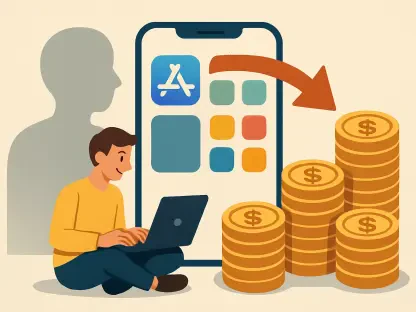Mobile payments have revolutionized today’s retail transactions by leveraging the capabilities of smart devices to facilitate secure and convenient digital payment methods. As technology continues to evolve, mobile payments are reshaping the retail landscape, offering enhancements to traditional cash and card transactions. With encryption technology ensuring heightened security, sellers and individuals can securely link their bank accounts, credit cards, and debit cards to enable seamless mobile payments. This article delves into how mobile payments are transforming modern retail transactions, covering their components, mechanisms, benefits, and future implications.
The Rise of Mobile Wallets
A mobile wallet, often regarded as the cornerstone of mobile payments, is essentially a digital version of a physical wallet stored on a user’s smartphone. With mobile wallets, consumers can seamlessly pay for goods and services by adding their bank, credit, or debit card details. The convenience and security offered by mobile wallets are substantial, as projections suggested that 1.6 billion consumers would engage in digital wallet payments at the point of sale (POS) by 2023. Furthermore, mobile wallets reduce the risk of physical theft and enhance security with encryption features, thanks to advancements in technology.
Platforms such as Apple Pay, Google Pay, and Samsung Pay have become household names, providing users with a secure and efficient way to manage their finances. These mobile wallets employ tokenization, a process that replaces sensitive information with unique identifiers, ensuring that personal data remains protected during transactions. This technology not only makes mobile wallets convenient but also presents them as a safer alternative to traditional payment methods. Users can complete transactions by simply tapping their smartphone, reducing the need to carry cash or multiple cards, and mitigating the risk of theft or loss.
As mobile wallets become more popular, their integration into daily life becomes more evident. From grocery shopping to dining out, consumers can rely on their smartphones to make payments, bypassing the need for physical cards or cash. Retailers are also recognizing the advantages of accepting mobile wallet payments, leading to a more streamlined checkout experience and improved customer satisfaction. Overall, mobile wallets are playing an increasingly crucial role in the retail sector by offering unparalleled convenience and security.
How Mobile Payments Work
The underlying technology behind mobile payments is near-field communication (NFC), which allows smart devices to share information when in close proximity. This technology, a subset of RFID, uses radio waves to identify and authenticate encrypted transactions securely. The requirement for close proximity in NFC transactions adds another layer of security, ensuring that only legitimate transactions occur. When a customer taps their smart device on an NFC-enabled POS system, the transaction is completed almost instantaneously, providing a seamless payment experience.
The ease and efficiency of NFC technology have made it a popular choice among retailers aiming to enhance the customer experience. The reduction in time spent at checkout is a significant benefit, as NFC-enabled mobile payments streamline the purchasing process, making it more efficient for both customers and retailers. Additionally, the use of encryption and tokenization ensures the security of each transaction, minimizing the risk of fraud and protecting sensitive customer information. This secure and efficient way of handling payments is one reason mobile payments are steadily gaining traction in the retail industry.
NFC technology’s adaptability is another factor contributing to its widespread acceptance. It can be used not only for payments but also for identification verification and access control. Some regions leverage NFC for purposes beyond retail transactions, such as public transportation and secure building entry. The versatility and security of NFC make it a reliable technology that has the potential to transform various aspects of daily life. As more advancements in mobile payment technology unfold, we can expect NFC to play an even more significant role in shaping the future of retail transactions.
Benefits of Mobile Payments
The adoption of mobile payments offers an array of benefits that primarily enhance convenience, speed, and security. These advantages contribute to a more seamless and efficient shopping experience, both for consumers and retailers.
Convenience
One significant benefit of mobile payments is the convenience they offer. Mobile payments eliminate the need for physical money, checks, gift cards, or even traditional cards, simplifying the payment process considerably. This added layer of convenience is especially valuable in a global crisis scenario, such as a pandemic, where contactless transactions are preferred. Consumers can make purchases with just a tap of their smartphone, foregoing the need to carry multiple payment methods. This aspect is particularly appealing in urban areas, where people often seek to minimize the items they carry for added ease and safety. With mobile payments, accessibility and ease in purchasing reflect the growing demand for hassle-free transaction methods.
Speed
The speed of transactions is another critical advantage of mobile payments. Whether online, in-store, or peer-to-peer, transactions are completed within seconds, significantly reducing checkout times and improving the overall customer experience. This increased efficiency is especially beneficial for retailers during peak shopping periods, helping to manage long queues and ensuring a smoother flow of customers. Rapid transactions foster more transactions in a shorter period, potentially increasing sales volumes and enhancing customer satisfaction. Fast payment methods, like mobile payments, cater to the demand for quicker and seamless retail experiences.
Security
Security remains a paramount concern in modern retail transactions, and mobile payments address this issue effectively. Each mobile wallet transaction generates a unique security code, which mitigates the risk of credit or debit card fraud. The use of tokenization replaces sensitive bank details with randomly generated numbers (tokens) to secure payment information, adding an extra layer of protection. This security feature makes mobile payments a safer option for both consumers and retailers, reducing the likelihood of data breaches and financial loss. Enhanced security measures contribute to the growing trust in mobile payment systems, encouraging more widespread adoption.
Types of Mobile Payments
Mobile payments can be categorized into various types, each designed to facilitate different transaction needs. The versatility and adaptability of these payment methods cater to the diverse preferences of consumers and retailers alike.
NFC Mobile Payments
NFC mobile payments, which utilize wireless data transfers between devices in close proximity, are among the most popular forms of mobile payments. Platforms like Google Pay, Apple Pay, and Samsung Pay leverage NFC technology for contactless payments globally. This method is also used in some regions for identification verification, replacing traditional chip technology. NFC mobile payments are particularly popular in urban areas where contactless payments are becoming a standard practice. The ease of use and quick transaction times make NFC mobile payments a favorite among consumers who value efficiency.
Retailers benefit significantly from adopting NFC mobile payment solutions as well. By incorporating NFC-enabled POS systems, retailers can offer a faster and more secure checkout experience. This not only improves customer satisfaction but can also lead to increased sales as the checkout process becomes more streamlined. The adoption of NFC mobile payments is a step towards future-proofing retail operations, aligning with the growing trend of contactless transactions.
Browser-based Mobile Payments
Browser-based mobile payments enable card-not-present (CNP) transactions, allowing consumers to input payment details on a website’s checkout page to complete transactions. This method is prevalent in the e-commerce sector, where consumers make purchases from the comfort of their homes. Browser-based mobile payments provide convenience and security, with many websites offering additional layers of protection, such as two-factor authentication. This type of payment is ideal for online shopping, giving consumers a hassle-free and secure way to finalize their purchases.
E-commerce businesses have increasingly integrated browser-based mobile payment options to cater to the rising demand for online shopping. Enhancing the security of these transactions is crucial for businesses to build trust with their customers. Techniques such as SSL encryption, tokenization, and multi-factor authentication are commonly employed to ensure safe browser-based transactions. As online shopping continues to gain popularity, browser-based mobile payments will remain an essential component of e-commerce operations, providing a secure and efficient payment solution.
In-app Mobile Payments
In-app mobile payments are a fast-growing category that allows users to make payments within an app, offering a seamless transaction experience. By registering their payment information, users can make purchases without leaving the app, enhancing the user experience and driving higher conversion rates. This method is particularly popular in the gaming and entertainment industries, where seamless transactions are crucial for maintaining user engagement. In-app payments enhance the convenience of purchasing digital goods and services, contributing to user satisfaction and loyalty.
The integration of in-app mobile payments presents numerous advantages for businesses, including increased customer retention and enhanced revenue opportunities. By streamlining the payment process, apps can provide a more intuitive and enjoyable user experience, encouraging repeat transactions. The ability to make quick, secure payments within an app also aligns with the growing consumer preference for convenience and efficiency. As the popularity of mobile apps continues to surge, in-app mobile payments are set to become an essential feature for businesses aiming to stay competitive in a digital-first economy.
Peer-to-peer Mobile Payments (P2P)
Peer-to-peer (P2P) mobile payments, facilitated by platforms like Venmo or PayPal, are straightforward money transfers between users’ smart devices. After entering bank or card details, users can send money to friends, split payments, and more. P2P payments have gained popularity for their convenience and ease of use, offering a simple way for individuals to manage their finances and share expenses. These transactions are ideal for small payments among peers, making them a convenient option for personal and informal financial exchanges.
The rise of P2P mobile payments reflects the changing dynamics of personal finance management. The convenience and speed of these transactions cater to individuals looking for efficient ways to handle their money. For example, splitting bills at a restaurant or repaying friends has never been easier with P2P payment platforms. The security measures employed by these platforms, including encryption and fraud detection, further enhance user trust and adoption. As digital finance continues to expand, P2P mobile payments will remain a key component of personal financial ecosystems, offering practicality and reliability.
Acceptance of Mobile Payments
With a notable 53% of merchants aiming to expand their mobile payment options in 2022, it is evident that mobile payments are becoming mainstream. As the retail industry evolves, businesses recognize the need to adapt to consumer preferences for digital and contactless payment methods. The implementation of mobile payment solutions requires a robust POS system equipped with the necessary technology to handle various types of mobile payments. Retailers who embrace these advancements stand to benefit significantly from the adoption of mobile payments, leading to improved customer satisfaction and increased sales.
A competent POS system should track sales data, increase revenue, and speed up transactions for a smoother checkout experience. Shopify’s POS system, for instance, supports mobile payments, offering a range of options for customers, whether they are making online or in-person purchases. By integrating payment processing with platforms like Shopify, retailers can streamline sales tracking from both online and offline transactions. This comprehensive approach to payment processing ensures a unified and efficient system that enhances business operations and provides valuable insights into sales patterns.
The acceptance of mobile payments also fosters a more inclusive retail environment. As mobile payment technology continues to advance, features such as Apple’s tap-to-pay are emerging, eliminating the need for hardware or physical payment hubs altogether. This functionality further enhances consumer security and privacy, promoting higher sales and fostering customer loyalty. Retailers who adopt such innovative payment solutions are better positioned to meet the evolving demands of today’s tech-savvy consumers. By embracing mobile payments, retailers can create a more dynamic and responsive shopping experience, ensuring they remain competitive in an increasingly digital market.
Conclusion
Mobile payments have completely transformed modern retail transactions, utilizing the advanced features of smart devices to create secure and convenient digital payment solutions. As technology continues to innovate, mobile payments are redefining the retail industry, enhancing traditional methods of cash and card transactions. With the use of encryption technology, these payments provide heightened security, allowing sellers and consumers to link their bank accounts, credit cards, and debit cards for seamless mobile transactions.
The transformation brought by mobile payments goes beyond just convenience; it represents a significant shift in how financial transactions are conducted. Security is a major factor, with encryption ensuring that personal and financial information remains protected. This means that both businesses and customers can confidently use mobile payments without the fear of fraud or data breaches.
This article explores the various aspects of mobile payments, how they work, and what makes them beneficial. It also delves into future implications, considering how further advancements might shape the retail landscape. From the technical components to practical advantages, mobile payments illustrate a forward-thinking approach to retail transactions, providing a glimpse into a more efficient and secure way of handling financial exchanges.









